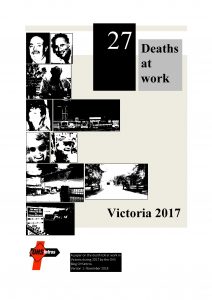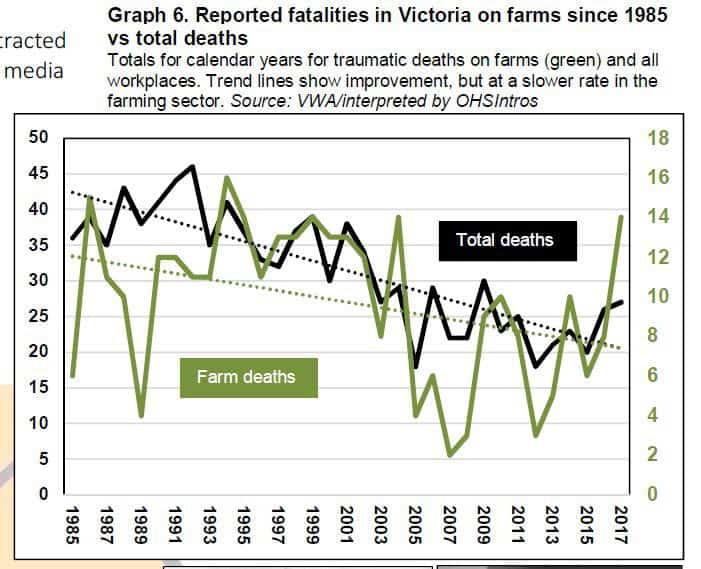 The latest paper from OHSIntros has been released, focusing on work-related fatalities in Victoria for 2017. These papers are produced independently but with good analysis. It’s not on the scale of “big data” but it does not need to be.
The latest paper from OHSIntros has been released, focusing on work-related fatalities in Victoria for 2017. These papers are produced independently but with good analysis. It’s not on the scale of “big data” but it does not need to be.
This article looks at the farm deaths data in the report, asks some long-overdue questions and offers radical safety scenarios.
In 2017, there were 14 deaths on farms, 8 more than the year before. The trend since 1985 has been a decline in farm deaths but not at the same rate as for the total deaths in Victoria.

SafetyAtWorkBlog has pointed out previously that many see the overall trend as a positive and claim that this proves that occupational health and safety (OHS) laws and their enforcement are working. This is a simplistic position that has persisted for decades, for to look too closely will show more could have been done.
OHSIntros provides some insight into this industry-wide and political complacency.
“In one media report, WorkSafe’s Hazardous industries and Industry Practice Head, Mark Coffey, said that the death rate should be enough for all farmers to “sit up and take notice and reassess how they are carrying out their activities.” (page 11, emphasis added)
There is some legislative support for this focus on farmers to take more care as the farmer, being an employer, has the primary duty of care for themselves and those affected by their work. A sad part of the nature of farming is that relatives are often the workers who are most at risk, personalising the socioeconomic effects of any farm death; to the extent that the trade unions are putting forward farming as a special case under their proposed Industrial Manslaughter laws.
The paper reports that
“.. the Victorian Farmers Federation’s (VFF) president David Jochinke… said the death toll was “unacceptable” which amped up the rhetoric on this matter. He called on the industry to “get serious about implementing a zero fatality target.” (page 11, emphasis and link added)
and
““We need to constantly remind ourselves that if we’re not careful, we will get hurt. You need to keep a well-stocked first aid kit wherever you’re working and if you work alone, make a plan on how you will seek help in an emergency,” (page 11, emphasis added)
Lastly, the paper says:
“…National Farmers Federation President (NFF), Fiona Simson …, added her voice by calling out the Victorian and national tolls as “tragic”. “We’re not doing enough when it comes to protecting our farmers, farming families, including children and farm workers.” She called on the industry to take “collective responsibility to reduce the instance of death and serious injury” and more government support for the long-standing FarmSafe body to equip it to do its work of helping farmers to reduce fatal hazards.” (page 11, emphasis and link added)
What Jochinke and Simson are missing is a point made elsewhere in the OHSIntros paper:
“Each year WorkSafe Victoria states that any death at work in unacceptable, but it is worse than that. In the view of OHSIntros, every death at work is a demonstration that the current OHS system is a failure. Every death is a reminder of that.” (page 3, emphasis added)
The farm industry quotes above acknowledge that not enough is being done and that we need to remind ourselves of the importance of OHS and that something called “the industry” needs to get serious. Both Jochinke and Simson represent the very industry that needs to get serious and hasn’t done enough! The VFF has failed to consistently have a dedicated farm safety officer and seems to rely on funding from WorkSafe Victoria for this position to be viable. NFF funds farm safety under its Workplace Relations sector.
When the OHS educational and awareness campaigns, and occasional enforcement actions, over 30 years have not controlled the hazards associated with farming, it is time to think outside the box.
In 2017 WorkSafe’s Marnie Williams forecast a new radicalism on farm safety but it has been difficult to find. Given the persistence of farm-related deaths and the propensity for agricultural groups to advocate repeating the same programs and approaches, radicalism on farm safety could include:
- The development of an OHS safety management system (OHSMS) template for all farms of less than 5 workers. This would personalise the OHS obligations, perhaps even in line with the Australian OHS Management Standard 45001, to that farmer’s industry which establishes a clear compliance benchmark.
- The establishment of such an OHSMS would allow for approved OHS consultants, under WorkSafe’s business support program, to extend their services into isolated rural areas.
- WorkSafe should establish a system of virtual OHS inspectors which supports the assessment of hazards remotely using whatever technologies can be drawn in. As this writer recently posed to a conference of OHS Inspectors, common technology like Skype, Facetime or other audiovisual communication tools could be used for direct discussions between a farmer and an inspector on matters of safety compliance. A farmer could take an Inspector on a real-time tour of the farm, or specific hazards, and receive immediate, official safety information and guidance.
- Apply clear return-on-investment performance criteria to any OHS funds provided to industry associations in the agriculture sector to ensure that tangible safety outcomes, not just awareness, is produced. Perhaps, penalties for under-performance can be structured into any grant or funding arrangement.
- A two-tiered set of OHS laws has been touted several times over the decades and dismissed as contrary to the intentions of the OHS laws. But, why not consider developing a different (sub)set of OHS laws specifically for family farms? Imagine if the family farm had no OHS laws and such laws and duties were to be created from scratch specifically for this sector. What would they look like? What duties would apply?
- A mandatory Construction Induction program was implemented for all construction workers across Australia many years ago and administered locally by each State’s OHS regulator, like WorkSafe Victoria. WorkSafe could develop, and mandate, a Farm Safety Induction program for all agricultural workers, extending it as part of the labour hire registration strategy. This would provide a safety benchmark for all farmers and one which WorkSafe could then assess for compliance.
- It is always best to test a program or system on a small section of a factory or industry, or State, before refining it and implementing it across the business. WorkSafe should consider developing radical OHS suggestions, formally trialling them and reporting on the success of, or barriers to, implementation.
- If the VFF or NFF want to participate in such programs and strategies, this should be encouraged, but no program should be developed that relies on their cooperation. Though, given the quotes by their Presidents above, non-participation would seem churlish.
- Instigate a cash prize of $10,000 for a unique farm safety innovation as part of the WorkSafe Awards program.
- Rediscover the Share Solutions program (pictured below) from the 1980s and 1990s, focusing on farm hazards. Redesign and refine each Share to form the basis of a Safety Share app that is free for all farmers. Offer $100 for every new farm safety solution shared through this app, which would be moderated by WorkSafe Victoria.
 Above all else, these suggestions, and any others that readers offer, should be assessed firstly by asking
Above all else, these suggestions, and any others that readers offer, should be assessed firstly by asking
“Why cannot this be done?”
The answers to this question will show the barriers to change that have embedded themselves in the OHS regulator and the farm sector since the introduction of OHS laws in the 1980s and which have existed generationally for a lot longer, such as
- Farms are far away – So communicate other way
- Farmers are set in their ways – So access their safety triggers in ways they accept
- It’s expensive for inspectors to travel there – When has it not been? Lobby the Victorian Government to redirect the millions it takes each year in dividends from WorkCover premiums to one of the most dangerous industries in Victoria. Or access a different funding source, such as philanthropy or crowd sourcing.
- Farmers don’t trust centralised governments – Farmers don’t trust any level of government. Get over it and develop new OHS advocate networks through networks and advocates they do trust. Or perhaps give the Country Women’s Association another try or approach newer farming associations such as Women in Farming Enterprises.
“safety differently” is an overused term that has become a trademark but the imperative to think differently about safety is more important than ever, and perhaps farming is the industry in which tests can be conducted. Farming is often self-contained and self-reliant with interactions that are readily recorded and monitored. The sector has been left to operate in a complacency or procrastination about workplace safety for too long and the industry quotes above indicated that this slow pace or inaction will continue. We owe it to the farmers to be radical about OHS, while we still have farmers.

I myself have tried and struggled with farmers to make things safer in their workplaces. No one is checking on them so they don’t seem to care. I went to Henty and Elmore this year in an attempt to have safety discussions. No one wanted to talk safety with the excuses of it costs too much, it’s not going to happen to me. So why does Worksafe not spend the appropriate portion of money on the most dangerous industry in the state? Is it because they don’t have big workcover claim rates or is it just too hard. Why are notices not being issued to farms that fail to comply with even the basic requirements of OHS. I understand that NSW are working on a Code of Practice for Farming and I am more than happy to discuss what could be created for farmers, but if they don’t want to do anything about their own situation then I have lives in other areas I can focus on.
It is usually unfair to generalise and there are some farmers that take their OHS obligations seriously. I know one who had trouble with the contractors she used who gave little thought to their own OHS. There was not a great choice of contractors available in her part of the country.
I have dabbled with farm safety for well over 20 years and farmers are more likely to accept OHS obligations when they are able to set the terms of meeting those obligations. They do not see these as being the same in the country as they are in the cities, because they see their industry as a special case with special needs. This attitude has largely persisted over my time and with little improvement. In my article I tried to suggest that MAYBE we should address the OHS obligations to meet this attitude rather than trying to change the attitude to meet the legal health and safety obligations. I don’t like to think what would result but the consultation could prove invaluable.
Hey Kevin, watch this space. Very soon there will be an exciting announcement about a radical change in the way agricultural cross sector collaboration is changing to address many of the ideas you’ve proposed. In particular funding applied research which hopefully will answer the key questions on how to bridge the gap between known risk controls and real-life, sustained practice. I’m really excited to be involved to help lead a new direction. Stay tuned